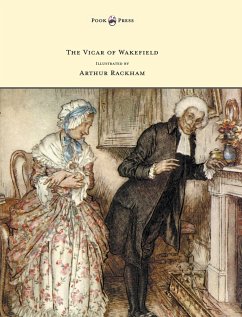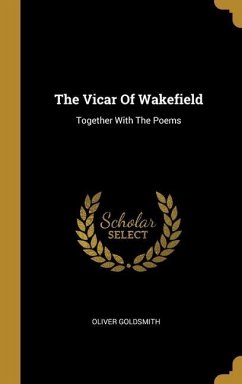The Vicar of Wakefield, subtitled A Tale, Supposed to be written by Himself, is a novel by Anglo-Irish writer Oliver Goldsmith (1728-1774). It was written from 1761 to 1762 and published in 1766. It was one of the most popular and widely read 18th-century novels among Victorians. In literary history books, The Vicar of Wakefield is often described as a sentimental novel, which displays the belief in the innate goodness of human beings. But it can also be read as a satire on the sentimental novel and its values, as the vicar's values are apparently not compatible with the real "sinful" world. It is only with Sir William Thornhill's help that he can get out of his calamities. Moreover, an analogy can be drawn between Mr. Primrose's suffering and the Book of Job. This is particularly relevant to the question of why evil exists. The novel is mentioned in "The Romance of Certain Old Clothes" by Henry James, George Eliot's Middlemarch, Stendhal's The Life of Henry Brulard, Arthur Schopenhauer's "The Art of Being Right", Jane Austen's Emma, Charles Dickens' A Tale of Two Cities and David Copperfield, Mary Shelley's Frankenstein, Sarah Grand's The Heavenly Twins, Charlotte Brontë's The Professor and Villette, Louisa May Alcott's Little Women and in Johann Wolfgang von Goethe's The Sorrows of Young Werther, as well as his Dichtung und Wahrheit. Goethe wrote: "Now Herder came, and together with his great knowledge brought many other aids and the later publications besides. Among these he announced to us the Vicar of Wakefield as an excellent work, with a German translation of which he would make us acquainted by reading it aloud to us himself. ... A Protestant country clergyman is, perhaps the most beatific subject for a modern idyl; he appears, like Melchizedek, as priest and king in one person." The Autobiography of Johann Goethe, p. 368 ff. A play The Vicar of Wakefield: A drama in 3 parts (1850) by Joseph Stirling Coyne. Silent film adaptations of the novel were produced in 1910, in 1913, and in 1916. In 1959 an Italian television series The Vicar of Wakefield was broadcast. Composer Liza Lehmann composed a 1906 comic light opera The Vicar of Wakefield to a libretto by Laurence Housman. (wikipedia.org) About the author: Oliver Goldsmith (10 November 1728 - 4 April 1774) was a well-known Anglo-Irish novelist, playwright, dramatist and poet, noted for his novel The Vicar of Wakefield (1766), his pastoral poem The Deserted Village (1770), and his plays The Good-Natur'd Man (1768) and She Stoops to Conquer (1771, first performed in 1773). He is thought by some to have written the classic children's tale The History of Little Goody Two-Shoes (1765). ... Among his papers was found the prospectus of an encyclopedia, to be called the Universal dictionary of the arts and sciences. He wished this to be the British equivalent of the Encyclopédie and it was to include comprehensive articles by Samuel Johnson, Edmund Burke, Adam Smith, Edward Gibbon, Sir Joshua Reynolds, Sir William Jones, Fox and Dr. Burney. The project, however, was not realised due to Goldsmith's death. ... His life was dramatised in the 1940 Australian radio play A Citizen of the World. Two characters in the 1951 comedy The Lavender Hill Mob quote the same line from Goldsmith's poem "The Traveller" - a subtle joke, because the film's plot involves the recasting of stolen gold. During the opening credits of the SKY One adaptation of Sir Terry Pratchett's Christmas-like story "The Hogfather", a portrait of Goldsmith is shown as part of a hall of memorials to those "inhumed" by the "Ankh-Morpork Assassins' Guild". ... (wikipedia.org)
Hinweis: Dieser Artikel kann nur an eine deutsche Lieferadresse ausgeliefert werden.
Hinweis: Dieser Artikel kann nur an eine deutsche Lieferadresse ausgeliefert werden.








